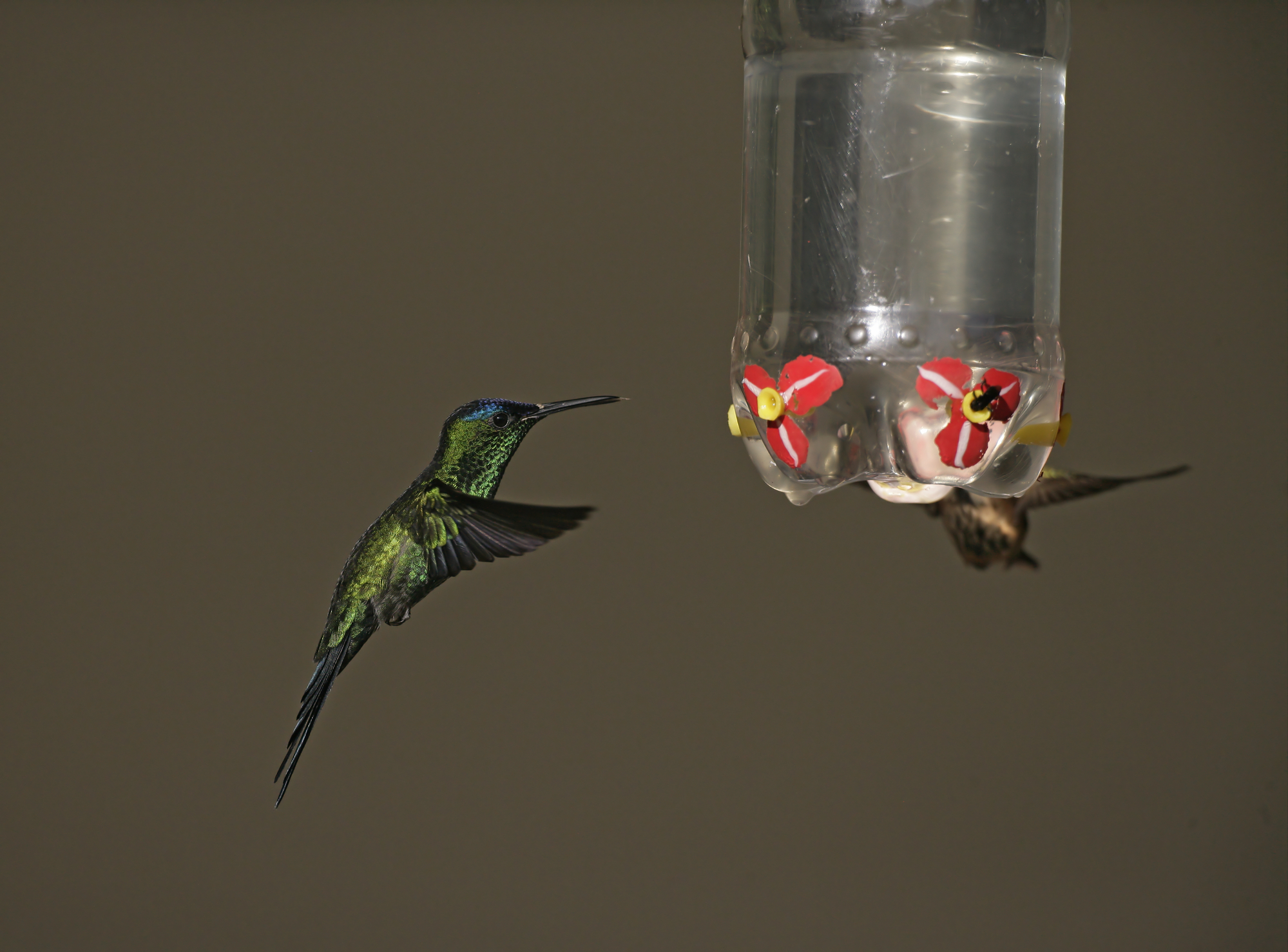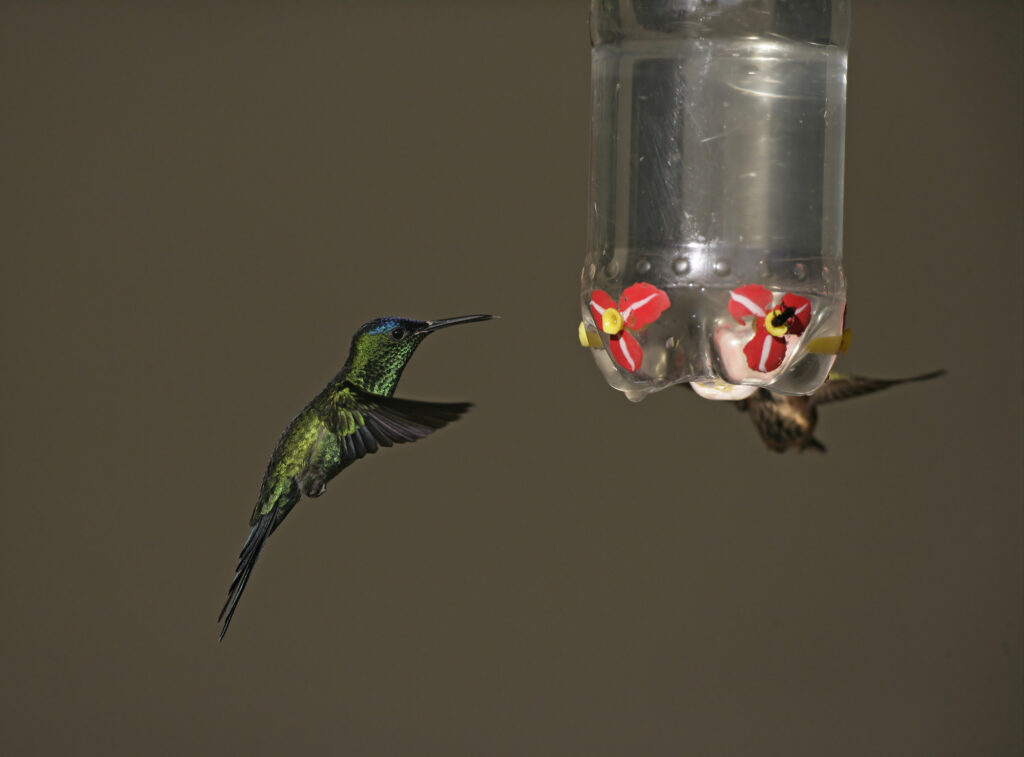A Hummingbird has arrived in your garden searching for some delicious nectar, but you don’t have a nectar feeder to offer it the sweet liquid it needs! Never fear; you can still give your little visitor an energy-boosting meal.
Helping out our little feathered friends is easy and only requires a few items you likely have around the house. These tips will ensure that your hummingbird friend will get the nutrition it needs without having to buy a feeder.
Feeding Hummingbirds Without a Feeder
Feeding hummingbirds is a great way to help and learn about these beautiful creatures. Not only will you be providing the birds with food, but you will get to enjoy their company as well!
A well-designed hummingbird feeder will save you a lot of time and money, but it is not required. You can still give these feathered friends a sugar-water treat without one.
Nectar in Open Containers
The easiest way to offer nectar to a hummingbird is to place it in an open container. A cup, bowl, or plate will work just fine!
Place red decoration around the edge of the dish to make it more visible to the hummer. Craft objects like pipe cleaners or non-toxic paints can be used for this purpose.
If you’re using a clear container, consider placing it on top of a red plate or napkin, making it more visible to the bird.
Use a shallow dish so that the hummer can easily reach the nectar. You may need to top off the nectar more often, but it will be worth it to see the bird up close!
Natural Nectar Sources
You can also offer hummingbirds nectar from flowers! Look for red, orange, or yellow blooms, as these colors are most attractive to the birds.
The trumpet-shaped flowers of the honeysuckle vine are a favorite of all types of hummingbirds. You can often find these vines growing wild in woods or along fences.
Other great choices for a hummingbird-friendly garden include:
- Impatiens
- Begonias
- Fuchsias
- Geraniums
- Petunias
- Clematis
- Cardinals
Attract Insects
While nectar makes up a large portion of a hummingbird’s diet, they also eat small insects. Offer them a source of protein by attracting insects to your yard with a water feature or some plants.
A birdbath or small pond is a great way to attract insects. Include some rocks or floating logs in the water for the bugs to land on.
You can also grow some plants that are known to attract insects. Good options include:
- Dill
- Fennel
- Parsley
- Cilantro
- Aphids
Homemade Hummingbird Feeders

If you want to offer nectar in a more traditional way, you can make a hummingbird feeder! All you need is a container and a way to suspend it.
A plastic bottle or glass jar works great for this project. Just be sure to use a red lid so the hummer can easily spot it.
Poke a few small holes in the lid and thread some fishing line through them to suspend the feeder from a tree branch or other structure.
Fill the container with nectar and screw on the lid. Hang the feeder in an area where you often see hungry hummingbirds and wait for them to come!
Great choices for containers include:
- Wine or water bottles. Plastic or glass works fine.
- PVC piping
- Red solo cups
- Small spice or baby food jars.
It may take some trial and error to craft the perfect feeder for your yard. But with a bit of patience, you’re sure to attract some feathered friends in no time.
Here are some of the best tips and advice to incorporate into your DIY project.
- Use red attractants – as mentioned before, hummingbirds are attracted to the color red. You can use this to your advantage by using red lids, cups, or even paint in your design.
- Make sure the holes are small – if the feeding ports in your feeder are too big, bees and wasps will be able to get in and ruin the nectar. Cut or punch small holes that are just big enough for the hummingbird’s beak.
- Make an ant-proof moat – ants are also attracted to the sweet nectar. They will crawl into the feeder and ruin it for the birds. To prevent this, make a moat out of water. Place the feeder on a plate and fill the moat with water. The ants will be unable to cross and get to the nectar. We recommend avoiding lubricant-based insect deterrents, such as vaseline, oil, or grease, as they can harm the birds.
Hummingbird Feeder Placement
Now that you’ve set up your feeder, it’s time to choose the perfect spot to hang it. Look for an area that is:
- Shady – too much sun will cause the nectar to spoil.
- Protected from the wind – a windy spot can make it difficult for the hummer to drink from the feeder.
- Away from windows – if the feeder is too close to a window, the bird may fly into the glass.
- Away from predator perches – you don’t want a predator to ambush the feeding hummingbird.
Can You Feed a Hummingbird by Hand?
One of the best things about hummingbirds is that, despite their tiny size, they are not that afraid of humans. This makes them fun to watch and easy to photograph.
You may be able to coax a hummingbird close enough to hand-feed it, but we don’t recommend it. These birds are very delicate and can be easily injured. It’s best to enjoy them from a distance.
If you think you can do so safely, you can utilize a hand-feeder. These are small tubes that you can hold up to the bird so it can drink.
Otherwise, you can do so under professional supervision. Lake Hope State Park in Ohio and Rocklands Bird Sanctuary in Jamaica are two of the most popular places to feed hummingbirds. Both have spent years conditioning birds to be comfortable around people to make hand feeding feasible.
Can Hummingbirds Survive Without Feeders?
In short, yes. While feeders can help hummingbirds survive in areas without a lot of natural food, they are not necessary for the birds to live.
Hummingbirds will migrate to wherever food is abundant. In the spring and summer, they will head to areas with lots of flowers and trees. In the fall, they will migrate to Central America, where there are plenty of insects to eat.
If you live in an area with many natural food sources for hummingbirds, you may not see many birds at your feeder because they don’t need it!
Can Hummingbirds Live on Just Sugar Water?
The sugar water you put in your hummingbird feeder is not enough to sustain the bird’s life. They need a variety of foods, including insects, to get all the nutrients they need.
Sugar water will give them energy, but it doesn’t have all the vitamins and minerals they need to survive. In particular, they need protein from insects to grow properly.
Final Thoughts
Now you know how to feed a hummingbird without a feeder! Just remember to keep the nectar fresh, the holes small, and the feeder in a safe place. And don’t forget that these birds need more than just sugar water to survive. A diet of live insects is essential for their health.

